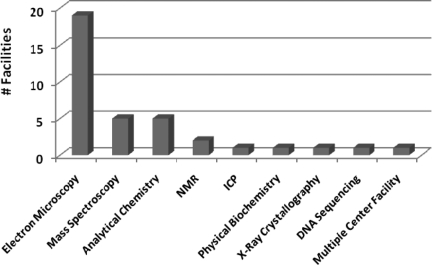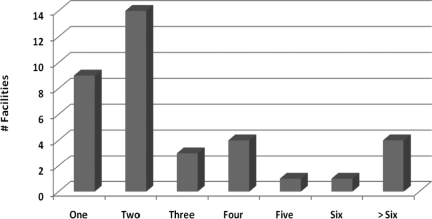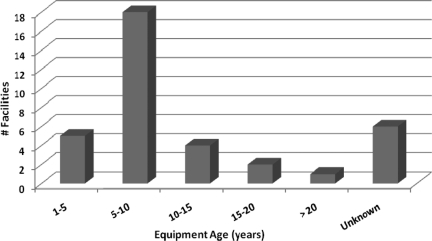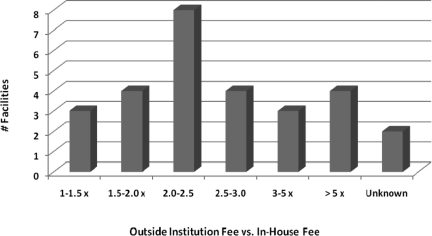Abstract
Multi-user facilities serve as a resource for many universities. In 2010, a survey was conducted investigating possible changes and successful characteristics of multi-user facilities, as well as identifying problems in facilities. Over 300 surveys were e-mailed to persons identified from university websites as being involved with multi-user facilities. Complete responses were received from 36 facilities with an average of 20 years of operation. Facilities were associated with specific departments (22%), colleges (22%), and university research centers (8.3%) or were not affiliated with any department or college within the university (47%). The five most important factors to succeed as a multi-user facility were: 1) maintaining an experienced, professional staff in an open atmosphere; 2) university-level support providing partial funding; 3) broad client base; 4) instrument training programs; and 5) an effective leader and engaged strategic advisory group. The most significant problems were: 1) inadequate university financial support and commitment; 2) problems recovering full service costs from university subsidies and user fees; 3) availability of funds to repair and upgrade equipment; 4) inability to retain highly qualified staff; and 5) unqualified users dirtying/damaging equipment. Further information related to these issues and to fee structure was solicited. Overall, there appeared to be a decline in university support for facilities and more emphasis on securing income by serving clients outside of the institution and by obtaining grants from entities outside of the university.
Keywords: institutional facilities, instrumentation, core laboratory, institutional support, core personnel
INTRODUCTION
The future of multi-user laboratories/core facilities, which have provided services for multiple individuals and research projects at colleges and universities in the past, may be in jeopardy. A survey was conducted by the Association of Biomolecular Resource Facilities Survey Committee in 2007 of its members, and the results were published in 2009.1 This survey pertained to services offered, cost recovery, funding for equipment, and the outlook for the future. The results in this survey indicated that the most important issue facing core facilities in 2007 related to funding. This issue did not depend on the type of facility—academic, government, or commercial. Over the past five years, funding at universities, especially public institutions, has become even more of a problem. To probe the impact of possible funding cuts, this study investigated multi-user core facilities, funds available to them, and factors that determine their success or failure.
MATERIALS AND METHODS
An e-mail survey was sent out in the Spring of 2010 in an attempt to identify the important factors in the maintenance of a successful multi-user facility within academic institutions and of the most common problems associated with these facilities, along with the possible changes in the operation of these facilities since 2007. The survey included questions related to the update and maintenance of equipment, age of equipment, and how the facilities were supported. The survey was distributed by e-mail to 365 individuals who were associated with laboratories identified as being multi-user facilities through studying internet sites of various institutions throughout the United States. In some cases, the survey was sent to more than one e-mail address associated with the same facility. The survey was conducted to help determine what characteristics are consistent among the facilities and to identify what makes for a successful establishment and operation and maintenance of these facilities. The results of this study were compared with previous studies to determine if recent financial problems associated with states and federal governments have affected the operation of these facilities. The questions associated with this survey are listed in bold italics in Results, followed by the information obtained. Identification of the facilities is not associated with any response.
RESULTS
Of the requests sent, there were 36 responses with complete information received that could be used. This was an approximate return rate of 10%. Six additional facilities responded but did not provide complete information associated with the survey questions. Many of these stated that they did not have time to complete the survey as a result of major time constraints. Of the respondents, 35 of 36 were associated with publicly funded universities. The average student enrollment of these universities ranged from 7148 to 54,227 in 2009, and the average enrollment was 22,556. A discussion of the results and implications of this survey, as well as comparisons with previous surveys, are located at the end of the survey results. Survey questions are in bold italics followed by responses.
1. Facility Characteristics
a. Name/Address of facility? No information is provided in this report as to specific facilities.
b. Type of facility? The types of facilities are shown in Fig. 1. A majority of the facilities was associated with the conduct of electron microscopy (EM).
FIGURE 1.
Types of facilities responding to survey. The facility identified with multiple centers had proteomics, X-ray, nuclear magnetic resonance spectrometry (NMR), materials characterization, mass spectrometry, biochemistry, and inductively coupled plasma spectrometry (ICP) centers administrated as one center.
c. Person in charge of facility and qualifications, or does the facility have a board that governs its operations? Of the 36 facilities, 32 were led by individuals with a Ph.D. degree, two were led by individuals with a Master's degree, and two did not state the training/education of the person managing the facility.
d. Number of people associated with the facility? There was some difficulty in differentiating the exact people and training of all individuals associated with facilities, so these are being presented as full-time equivalents (Fig. 2). A majority of the facilities (63.9%) was operated by one to two full-time personnel. Additional people are working within the facilities but are not full-time.
FIGURE 2.
Number of full-time personnel associated with the operation of multi-user facilities.
e. Is the facility associated with a department, or is it an independent, free-standing unit? The location of the facilities within the college/university structure varied. Eight of the facilities were associated with a specific department (22.2%), eight were within a specific college (22.2%), and three were university research centers (8.3%). A majority, 17, was not affiliated with any department or college within the university (47.2%).
f. How long has the facility been in operation? The number of years of operation associated with facilities completing the survey ranged from 2 to 54 years. The average number of years of operation was 19.6.
2. What Do You Consider As the Five Most Important Factors in Development of a Successful Multi-User Facility?
The top five responses are listed below. Some surveys did not supply five factors. The number in parentheses after the response is the number of facilities that submitted that response.
Having experienced, professional staff to provide a friendly, open atmosphere and who are willing to work with people less knowledgeable in their technology (20).
Having university-level support to at least partially fund the facility. Several facilities replied that there was no way to completely fund the facility through user fees (22).
Having a wide user base that needs the facility, along with a facility that responds to their needs by providing updated, state-of-the-art equipment (22).
Having an instrument-training program to prevent contamination and damage to equipment (16).
Having an effective facility and an involved strategic advisory group (17).
Other responses included: no user fees (4), reasonable fees (3), maintain service contracts (4), ability to repair equipment (3), open access to all equipment (1), broad focus (2), and respect and encouragement from department (1).
3. Problems with Multi-User Facilities
a. What do you consider as the most important problem in the operation of a multi-user facility? The most important problem corresponds to the important factors for a successful multi-user facility identified in Question 2. The number in parentheses following the response is the number of facilities that submitted that response.
Inadequate university-level financial support and commitment (22).
Problems balancing the cost between university subsidies and user fees (8).
Availability of funding for repairs and upgrade of equipment (8).
Inability to provide an adequate salary to retain highly qualified staff, capable of interacting with a range of client personalities (7).
Unqualified users dirtying/damaging equipment (7).
b. What do you see as a way to remedy this problem? The major remedy suggested for dirtying/damaging equipment was to educate the users. It was noted that this task takes a considerable amount of time and is often achieved by conducting formal training classes.
No solution was seen to the budgetary crisis at the current time.
c. How are new or updates of equipment funded? Grants supplied at least a portion of the cost associated with the purchase of new equipment in 90.4% of facilities when combined with user fees and/or university funding. Grants supplied complete funding for 32.3% of new equipment. User fees funded new equipment purchases in only 9.7% of facilities. When separating out the EM facilities, user fees did not supply the full funding of any new major equipment. Grants funded 35.3% of funding of new equipment, and 64.7% of new equipment was funded partially by grants with a combination of university and user fees.
d. What is the age of the major equipment items associated with the facility? The average age of a majority of the equipment associated with multi-user facilities is 5–10 years (Fig. 3). Problems obtaining parts for instruments more than 10 years old are common, but these results clearly illustrate that some equipment is being used past a 10-year operational life. When separating out the EM facilities, 66.7% of equipment is 5–10 years, and 20% is 0–5 years compared with non-EM facilities, where 56.3% of equipment was 5–10 years, and 12.2% was 0–5 years.
FIGURE 3.
Average age of equipment associated with multi-user facilities.
e. How often is equipment updated? Based on the survey, equipment is often updated based on need, maintenance, and funding availability (available grants; 37.1%). Rarely and never updating were mentioned in 8.7% of the facilities. There was no consistent response.
f. Is equipment covered by a service contract? A majority of the equipment associated with multi-user facilities is covered by a service contract (75.0%). Because of time constraints on equipment and not having time to have equipment unavailable, these service contracts were considered by the facilities responding to be a vital component for the facilities.
g. Are service contracts with the equipment manufacturer or an outside vendor? In facilities with service contracts for equipment, the service contract is most commonly with the equipment manufacturer (89.3%). Only 3.5% stated that their service contract was with an outside vendor. In most cases where an outside vendor supplied the service, the service engineer actually repairing equipment was associated with the original manufacturer. The supplier of the service contract was not stated in 7.1% of the cases.
4. Support
a. Is the facility completely self-supporting, partially subsidized, or fully subsidized? Only 5.7% of the facilities stated that they were completely self-supporting. Most received a partial subsidy from their university.
b. If partially or fully subsidized, from where do the funds come, and what and how much are covered (percentages are fine)? The support of facilities came from a variety of sources, including grants, user fees, and university support. Grants were supporting three facilities between 7.5% and 40%. Of the facilities that gave the percentage of their operation costs that were covered by user fees, the average was 60.5%. Seven facilities did not provide a breakdown.
c. Are salaries of any of the employees covered in support? In a majority of the facilities surveyed, the salaries are covered by the college/university, and 57.1% of the salaries are fully covered and 25.7% partially covered. Only 5.7% were not covered. There was 11.4% of the surveys where this could not be determined.
d. Are any of the expenses covered? Electrical? Service contracts? Paper and computer resources? In many facilities, electrical expenses are covered by the university, but other expenses, such as service contracts and computer resources, are considered part of the facility expenses, which are not generally covered by the university.
e. Has the support changed over the past few years, and how has it changed if it has changed? Very few facilities have seen an increase in support over the last few years (8.6%), and many have seen decreases (48.6%). Approximately one-third (34.3%) had the same amount of income available to them, although 11 out of 12 of these facilities were entirely self-supporting
f. Do you train individuals such as graduate students on the use of equipment, or is analysis and operation of equipment done by employees within the facility? All facilities have some training associated with the use of equipment. Many offered graduate classes, for which students received university credit.
5. Fee Structure
a. Do you have separate fee structures for in-house, in-college, or within-institution compared with outside entities? Most facilities have separate fee structures for in-house versus outside entities (77.7%). One facility did not conduct any work for outside entities (2.8%), and two did not answer this question (5.7%). Three facilities had the same fee structure for in-house versus outside entities (11.4%), and one did not state if there was a difference in the fees.
b. How much is the difference in fees between in-house and outside entities if they exist? The fees for outside entities versus the in-house user fees vary from the same rate to greater than five times the in-house rates (Fig. 4). In general, there is not consistency in the user fees. In separating out the EM facilities, 46.2% of facilities have an outside fee at 2–2.5 times in-house fees. A higher percentage of fees >2.5 times in-house fees was associated with EM facilities (30.8%) when compared with in-house facilities (22.2%).
FIGURE 4.
Difference between fees charged for in-house versus outside the institution users.
c. Do you have multiple sample discounts? How are these determined? What is considered multiple samples? Few facilities offered discounts for multiple samples. Many respondents did not answer this question.
d. How often is the fee structure updated? The more common response was that fee structure was updated yearly (42.9%) or every-other year (17.1%). Other responses were every 3 years (2.9%), every 5 years (5.7%), and updated as needed (11.4%).
e. What are the fees expected to cover in the facility? In a majority of the facilities, the salaries of people working in the facilities are at least partially covered by the university. User fees, in general, cover the maintenance and operation of equipment, as well as covering consumables.
f. If possible, could you supply a copy of your fee schedule? This information is summarized in previous sections.
DISCUSSION
The results of this survey seem to indicate that the major problem for core or multi-user facilities remains the same as reported in 20091—financial resources. The bottom line, expressed by all respondents, was that finances are getting harder to obtain. Of the respondents, only two of 36 facilities were run strictly on user fees. The salaries of personnel were covered completely in 21 of the 36 facilities. Only two facilities had no salaries covered by the institution. Fourteen facilities had ratios of user fees:university support of between 70:30 and 30:70, and the most common split was 50:50. In the previous study, this was also evident, even when they deleted the core manager from the cost to operate the facility.
The comparison of fees for in-house versus outside users indicates that this area has changed since the 2000 report,2 where nonprofit laboratories reported charging an average of 60% more for outside users of their facilities. At that time, the extreme reported charging as high as three times the in-house rate. Now, the median rate for outside users is 2–2.5 times the in-house rate, and >25% of facilities charge outside users >2.5 times the in-house rate. This change seems to indicate that more emphasis is being placed on having outside users pay a greater share of the costs of operations. This may be a result of tighter budgets at the institutional level and needing to look for alternatives to replace institutional support that had been present in the past.
In terms of personnel, the average number of personnel would appear to be continuing to decrease. One to two personnel were associated with 63.9% of the facilities, and the average across all laboratories was 2.7 in this survey. The survey in 19982 reported an average of 3.1 full-time personnel, whereas a previous study in 1992 had reported an average of 4.1 full-time personnel.3 These figures are especially discouraging. Without personnel, multi-user facilities cannot function and survive. Equipment does not work long when there is no one to oversee its correct operation and maintenance.
Overall, the results of this survey are somewhat discouraging. Financial constraints may ultimately push core facilities out of operation, as a result of inadequate support, especially when considering the funding of personnel to operate the facilities. The most important thing for facilities to do is to continue to pursue and to emphasize their ability to advance the research conducted at their institutions, while also advertising to the clientele and demonstrating how they are important, so that the institution's community knows about the importance of its operation and how it can be beneficial to the individual researcher. Facilities must have a wide community of individuals at the institution and outside the institution willing to back their funding and operations for existence into the future.
ACKNOWLEDGMENTS
This study is Technical Contribution No. 5922 of the Clemson University Experiment Station and is based on work supported by National Institute of Food and Agriculture/U.S. Department of Agriculture under project number SC-1700389. The assistance of Fran Harper in compiling survey results is greatly appreciated.
REFERENCES
- 1. Ogorzalek Loo R, Nicolet CM, Niece RL, Young M, Simpson JT. Association of Biomolecular Resource Facilities survey: service laboratory funding. J Biomol Tech 2009;20:180–185 [PMC free article] [PubMed] [Google Scholar]
- 2. McMillen DA, Bibbs L, Denslow N, et al. Biotechnology core laboratories: an overview. J Biomol Tech 2000;11:1–11 [PMC free article] [PubMed] [Google Scholar]
- 3. Ivanetich KM, Niece RL, Rohde M, Fowler E, Hayes TK. Biotechnology core facilities: trends and update. FASEB J 1993;7:1109–1114 [DOI] [PubMed] [Google Scholar]






